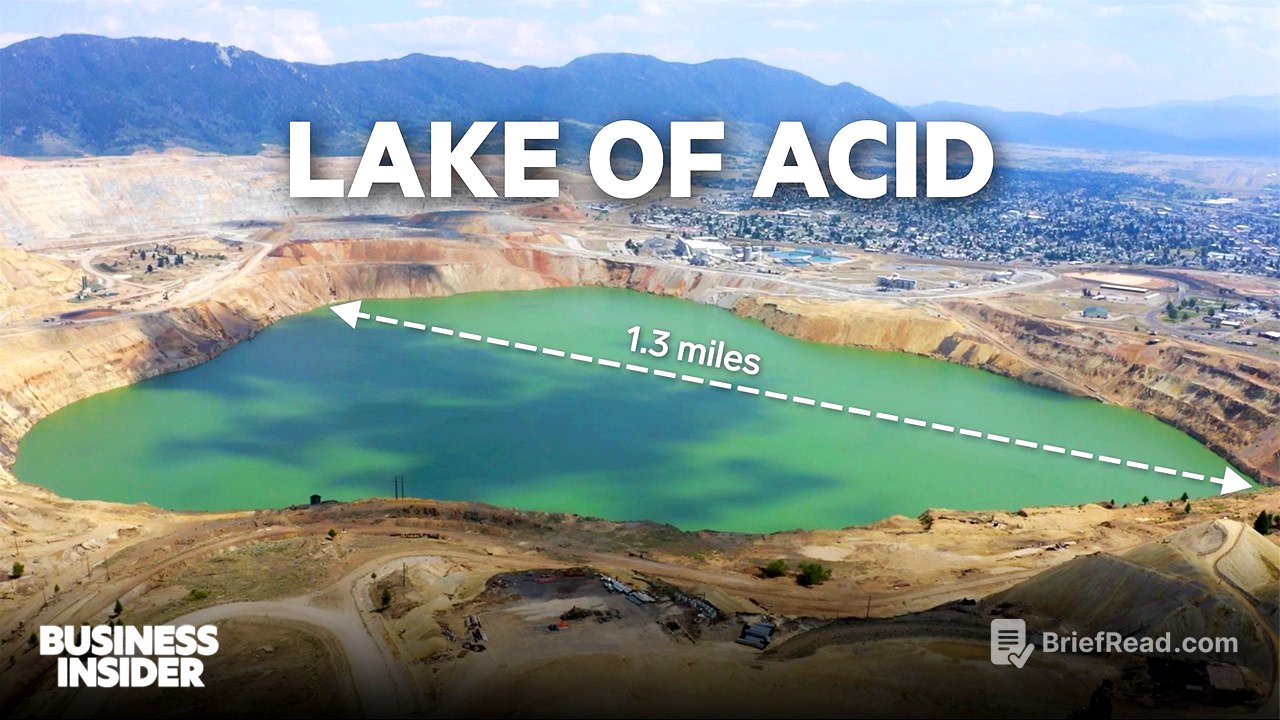TLDR;
This video explores 15 of the world's most toxic places and the people who live and work there. It highlights the challenges and risks associated with these environments, from polluted water and air to dangerous waste and abandoned mines. The video also showcases the resilience and ingenuity of individuals who are working to make a living and improve their communities despite these difficult circumstances.
- The video explores the impact of pollution on human health, wildlife, and the environment.
- It highlights the challenges of cleaning up toxic waste and the importance of sustainable practices.
- It showcases the stories of individuals who are working to make a living and improve their communities despite these difficult circumstances.
Centralia, Pennsylvania [0:00]
The video begins with a visit to Centralia, Pennsylvania, a ghost town that was abandoned due to an underground coal seam fire that has been burning for over 60 years. The fire continues to release toxic steam and heat, making the area uninhabitable.
Butte, Montana [0:44]
The video then travels to Butte, Montana, where a former copper mine has become a toxic bird bath. The acidic water in the Berkeley Pit attracts millions of migrating birds, many of which die after landing on the water. Mark Mariano, a water fowl protection specialist, uses a variety of high-tech tools to scare birds away from the pit, including drones, lasers, and propane cannons.
Corning, Ohio [11:03]
In Corning, Ohio, a 100-year-old coal mine continues to pollute the surrounding area with iron oxide. A team of artists has developed a method to harvest the toxic sludge and turn it into paint, raising awareness about the region's toxic legacy. The process involves collecting the iron oxide, filtering it, drying it, and then using it to create paint.
Ashford, West Virginia [19:58]
The video then visits Ashford, West Virginia, where a former coal mine has been transformed into a lavender farm. Appalachian Botanical Company (ABCO) is working to reclaim the land and provide jobs for former coal miners. Lavender is a hardy plant that can thrive in poor soils and can actually help to reduce toxic heavy metals in the soil. ABCO uses every part of the lavender plant, from the flowers to the stems, to create a variety of products, including essential oils, creams, and compost.
Bhalswa Landfill — Delhi, India [26:27]
The video then travels to Delhi, India, where the Bhalswa landfill is one of the largest in the world. The landfill is a major source of air pollution and greenhouse gases, and it is prone to fires. Thousands of people risk their lives collecting trash in the landfill, sorting through all kinds of waste, including used syringes. The fires pose a serious health risk to the people who live and work nearby.
Seelampur, India [34:43]
The video then focuses on Seelampur, India, a neighborhood where around 50,000 people scavenge through old electronics each day. India has become the world's biggest dumping ground for electronic waste, much of which is processed and recycled manually, often by underage children. The e-waste is full of toxic chemicals, but it also contains valuable materials like copper, platinum, and gold.
Ganges River, India [45:40]
The video then explores the Ganges River, one of the most polluted rivers in the world. The river is filled with untreated sewage, but it also receives a significant amount of waste from religious rituals. After being used in worship, tons of flower garlands are dumped into the river each day, along with other religious leftovers like idols. A handful of startups are working to turn flower waste into natural dyes, incense, and other products, proving that it is possible to make money while respecting ancient practices and cleaning up the environment.
Jharkhand, India [1:01:00]
The video then travels to Jharkhand, India, where coal mines have been burning relentlessly beneath the surface for over a century. Teenage miners risk their lives working in these dangerous conditions, inhaling toxic fumes and burning their hands and feet. The coal deposits contaminate nearby rivers and streams, posing a serious health risk to the local population.
Jakarta Bay, Indonesia [1:12:03]
The video then moves to Jakarta Bay, Indonesia, where widows scavenge for rusted scrap metal from used ships. The women search for iron and steel in one of the most polluted waters in the world, risking their health and safety to make a living. The ship recycling industry is a multi-billion dollar global industry, but the women who scavenge for scrap metal make only about $2 a day.
Bekasi City, Indonesia [1:23:43]
The video then visits Bekasi City, Indonesia, where thousands of people live and work in the Bantar Gebang landfill, one of the largest in the world. The landfill is a major source of pollution and health risks, but it provides a livelihood for many people who scavenge for recyclable materials. The landfill is also a source of methane gas, which can be dangerous if it is not properly managed.
Java, Indonesia [1:34:39]
The video then travels to East Java, Indonesia, where locals extract oil from old, toxic wells. The wells were built by the Dutch in the late 1800s, and they continue to leak oil and pollute the surrounding environment. Workers risk their lives to extract the little oil that is left, but they are forced to sell it to the state company at a low price.
Newark, NJ [1:51:14]
The video then returns to the United States, focusing on the Ironbound neighborhood in Newark, New Jersey, one of the most polluted neighborhoods in the country. The neighborhood is home to a variety of polluting industries, including a garbage incinerator, a factory that melts down animal parts, and a large sewage plant. The pollution has a significant impact on the health of the residents, particularly children, who have high rates of asthma and other respiratory problems.
Oil City, Louisiana [2:04:42]
The video then travels to Oil City, Louisiana, a town that was named after the early 20th century oil boom. The town is riddled with orphan oil and gas wells, which are wells that have been abandoned and are no longer properly sealed. These wells leak methane and other toxic gases, posing a serious environmental and health risk. Curtis Schu, a retired oil executive, is working to plug these wells with his nonprofit, the Well Done Foundation.
Kyiv Region, Ukraine [2:18:26]
The video then explores the challenges of managing nuclear waste in Ukraine, particularly in the wake of the Russian invasion. The Chernobyl nuclear power plant, site of the worst nuclear disaster in history, is still a source of radioactive waste. The war has raised concerns about the safety of nuclear materials in Ukraine, and there have been several close calls.
Al-Bab, Syria [2:27:11]
The video concludes with a visit to Al-Bab, Syria, an area filled with makeshift crude oil refineries. The refineries release toxic chemicals into the air, posing a health risk to the workers, many of whom are children. The refineries are a source of fuel for the local population, but they also contribute to the pollution of the environment.









